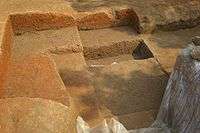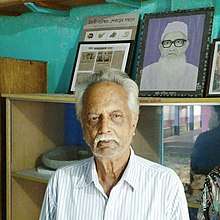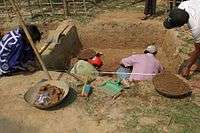Wari-Bateshwar ruins
The Wari-Bateshwar region (Bengali: উয়ারী-বটেশ্বর Uari-Bôṭeshshor) in Narsingdi, Bangladesh is the site of an ancient fort city, based on the artifacts found here the city was alive dating back to about 2000 BC (or more) to 450 BC. [1] The 2500-years- more older ruins being unearthed near the old course of the Brahmaputra River are a major archaeological discovery in the South Asia. It challenges the earlier notions of early urban civilization in the Bengal.
Part of a series on the |
|---|
| History of Bangladesh |
 |
|
|
Ancient
|
|
Classical
|
|
Medieval
|
|
Modern
|
|
|
Related articles |
|
|

As because discovery of a pit-dwelling is first of its kind in Bangladesh. The pit-dwelling is a Copper Age or Chalcolithic artefact. Similar pit-dwellings have been found in India and Pakistan which are believed to be 4000 years old. Therefore it beliefs that the উয়ারী-বটেশ্বর civilizations is much older than the time which explained in the Banglapedia of the Asiatic Society.
Later it was part of the ancient region of Samatata.
Geography
The site is about 70 km north-east from Dhaka situated at Narsingdi's Belabo Upazila and Shibpur Upazila's neighbouring village Wari and Bateshwar.
Discovery
Wari-Bateshwar discovery

In the neighbouring villages of Wari and Bateshwar, many archaeological artifacts were discovered upon digging. In the Wari village in 1933, some local diggers found a pot full of ancient coins dating back to between 450 BC to 300 BC while digging in the undiscovered grounds of Wari-Bateshwar. A local school teacher, Hanif Pathan, collected 20–30 of the ancient coins from there. After that, he made his son Habibullah Pathan aware of this incident. In 1955, Bateshwar village, some diggers left behind two ancient metal-made things. Habibullah Pathan showed these items to his father. Then in 1956, during digging in Wari-Bateshwar, an ancient silver coin storage buried underground was discovered. In 1976 Habibullahh Pathan collected many archaeological things from Wari-Bateshwar and submitted these items to the Dhaka National Museum. In 2000 under the order of Jahangir Nagar University's archaeologist Professor Sufi Mostafizur Rahman, a digging expedition was begun in Wari-Bateshwar. Discoveries include ancient roads, houses, terracotta, silver coins, hand crafted metal objects, printed currencies, weapons and a host of other artifacts.
Religious discoveries
About 14 km away from Wari-Bateshwar in Shibpur Upazila in a village named Mondirbhita one Buddhist temple was found. In another village named Jankhartek a big Buddha temple was found which suggests that the residents of Wari-Bateshwar were Buddhists. However as the civilization was developed before born of the Buddha, therefore now it is questions that what was religious belief of the people lived in the civilization before the Buddism was starts, and as because there is no evidence found that they ware prayed in front of any statue, so some researcher are thinking that maybe they ware practice in Abrahamic Religion; the Judaism. Because no record found in the ruins/city that they ware used to worshipped IDOLS therefore it is clear that they were not Hindus, and Buddha was not born during the periods.
The site of Wari-Bateshwar is very important regarding development of religion in ancient Bangladesh. From the discovered stone slab and punch mark coins we do get an idea of the religious attributes of the civilization. Symbols of 'Swastika' and 'Nandipada' is found on the stone slab. Whereas the Coins comes with punch marks of solar symbol and six armed figurine, there are also mountain symbols with crescent found on coins. Swastika is common aspect of all Indic religions and used extensively since Vedic Hinduism. Whereas Nandipada and mountains with crescent is a known depiction of 'Shiva' in ancient times before the image icon of Shiva came into existence. On the other hand the depiction of Sun God on the coins suggest that the civilization held Sun in high esteem, which is resembles Hinduism's reverence to 'Surya' the Sun God[2] Therefore from scholarly viewpoint it is acknowledged that people in Wari- Bateshwar civilization was probably practicing an ancient form of pre temple aspect of Hinduism.
Some other discoveries
Nearly 50 ancient archaeological sites have been found around Wari-Bateshwar, with most of the discoveries being settlements. Some of them are known as Rangartek, Sonartula, Kendua, Morjal, Tongirajar Bari, Mondirbhita, Jankhartek, Tongirtek.
History
Prof. Rahman believes that Wari-Bateshwar is the rich, well planned, ancient emporium (a commercial city) "Sounagora" mentioned by Greek geographer, astronomer, mathematician Ptolemy in his book Geographia.[3] The other emporia mentioned in Ptolemy's work include Arikamedu of India, Mantai of Sri Lanka, Kion Thom of Thailand. All of these were the most ancient civilisations in their respective regions, each was a river port, and all of them produced monochrome glass beads. The artifacts found at Wari-Bateshwar bear similarity with those found in the other emporia sites. Mathematician Narayan Chandra Ghosh, though now a resident of Kolkata his birthplace is Satirpara-Narsingdi, visited Wari-Bateshwar on 30 June 2016 to collect detailed information about mathematical concepts used there. He has popularised the word 'Folk Mathematics' that he has found at Wari-Bateshwar also. Mathematician Narayan Ch Ghosh, former student of Satirpara K.K. Institution, from Kolkata visited this place on July 2016 for identifying mathematical concepts used there. He has written articles on Wari-Bateshwar in Daily Desher Katha (Published from Agartala), Chalojai published from Kolkata.
Artifacts
According to researchers, the discovery of rouletted ware, knobbed ware, stone beads, sandwiched glass beads, gold-foil glass beads, Indo-Pacific monochrome glass beads and importantly its geographical location indicates to southeast Asiatic and Roman contacts.[4][5]

Excavation also unearthed the presence of pit-dwelling. The discovery of a pit-dwelling is the first of its kind in Bangladesh. People used to live in these small ditches. The pit-dwelling is a Copper Age or Chalcolithic artefact. Similar pit-dwellings have been found in India and Pakistan which are believed to be 4000 years old. The unearthing of a 180-metre long, six-metre wide and 21–35 cm thick road with a by-lane points to very early urbanisation in this area. Before the discovery of this, the widely held view was that urbanisation occurred later than the Wari-Bateshwar ruins indicate.

Silver punch-marked coins, different types of earthen pots, rouletted ware, knobbed ware, northern black polished ware, black-slipped ware, common ceramics, semi-precious stone beads. Iron artefacts include blooms, hand-axes, spearheads, knives, nails and slugs, melted pieces of iron. It is also suspected that it might be the oldest place in the world which have a money based currency system.
See also
External links
| Wikimedia Commons has media related to Wari-Bateshwar ruins. |
- Wari-Bateshwar in Banglapedia
- MM Hoque and SS Mostafizur Rahman, Wari-Bateshwar, Banglapedia: The National Encyclopedia of Bangladesh, Asiatic Society of Bangladesh, Dhaka, Retrieved: 20 February 2012
- https://www.academia.edu/2086774/Religious_and_Auspicious_Symbols_Depicted_on_Artifacts_of_Wari-Bateshwar
- Kamrul Hasan Khan (1 April 2007). "Wari-Bateswar reminds Ptolemy's 'Sounagoura'". The Daily Star.
- Excavation at Wari-Bateshwar: A Preliminary Study. Edited by Enamul Haque. Dhaka, The International Centre for Study of Bengal Art, 2001, ISBN 984-8140-02-6
- Dilip Kumar Chakrabarti (1992). Ancient Bangladesh. Dhaka: Oxford University Press. pp. 64–65. ISBN 0-19-562879-9.
Large-scale use of silver for punch-marked coins, the extensive import of iron blooms for manufacturing activities, the variety of semi-precious stones which were brought to the site for the manufacture of beads for export—all these go a long way in establishing the fact that the Wari-Bateshwar area was closely linked to an internal trade network of the subcontinent. However, we doubt very much if the significance of this zone depended only on internal trade. First of all, we argue that there was an early historic riverine route from the Meghna delta to Assam along the Brahmaputra and that this zone, because of its position at the confluence of the contemporary flows of the Brahmaputra and Meghna, played an important role in handling its traffic ... we argue that the Wari-Bateshwar area could cater both to the southeast Asiatic and Roman trades of the Bengal delta.